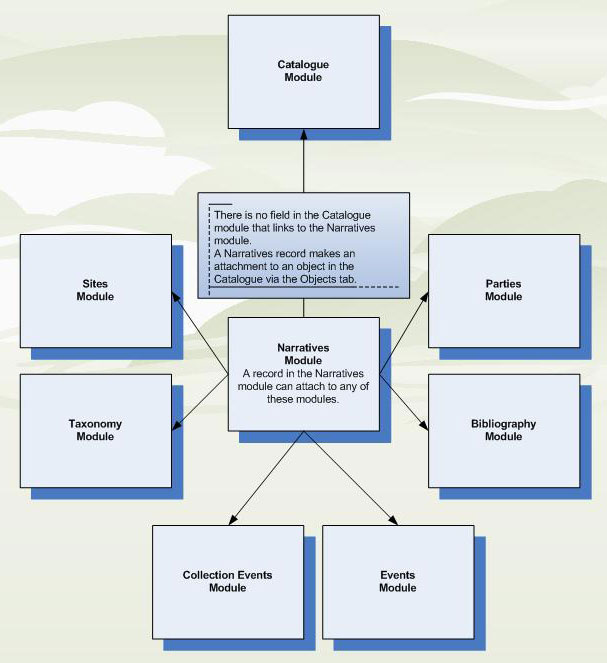The Narratives module is perhaps most powerful as the public face of your collection: as the content management tool for a website that presents a collection to the world. But this is by no means its only function. Others include:
- Labels for exhibits.
- Textual descriptions for brochures and programs.
- Miscellaneous internal (non-public) information management, e.g. a record of conversations held or correspondence sent and received.
- Providing researchers (specialist and private or public) with purpose-made (tailored) material.
The Narratives module brings together related and diverse information about a particular object, collection of objects or subject, linking a collection in significant ways. As with EMu's Catalogue, which is surrounded by a suite of modules, the Narratives module draws data from a range of satellite modules. Depending on the nature of a collection (Natural History vs Cultural History, for instance) a narrative record can draw data from the Parties, Bibliography, Events, Collection Events, Taxonomy and Sites modules:

The Narratives module records stories about the collections from item level to collection groupings and a multitude of other collections related angles. It helps structure these stories for different types of publication, including delivery to the web. It stores historically significant, general or even ephemeral information gathered about the collections. In short, the Narratives module is designed to hold any interpretative information about a collection, as well as references to all of the resources (EMu and non-EMu) used to author it.
However, the versatility and flexibility of the Narratives module are not limited to its uses. As we'll see, even when it comes to presenting a collection online, there are several ways to achieve this end, each with its advantages.
More often than not the Narratives module will be the public face of a collection, whether it is used to store labels, record interviews and correspondence, serve information to researchers or, most crucially, as the content management tool for a website that presents a collection to the world. With that in mind, and as we look at how to use the Narratives module, it is worth considering some basic editorial precautions that control:
- the language used (choice of words, spelling);
- the layout and format of text; and
- what data is completed / compulsory for a Narratives record.
There are a variety of techniques available to tighten up editorial control of content, including:
- using read-only Lookup Lists (so that only terms in an approved list can be used);
- linking fields to the Thesaurus module; and
- making fields mandatory.
These options are covered extensively in the EMu Help.
To control the layout and formatting of the text of a narrative you have the option of using one of two Narrative tabs (you could even include both in your version of the Narratives module if that was appropriate):
- a plain text tab (which could be used for marking up text using HTML tags);
and
- a formatted text tab (a basic WYSISWYG text editor).
To limit formatting of text you could, as some institutions have, mandate use of the plain text tab and restrict which HTML formatting tags are used.
Note: Restricting the use of HTML tags takes the form of a staff policy ("Staff will not use HTML tags...") rather than programming control.
We look at these two Narrative tabs in more detail here.

